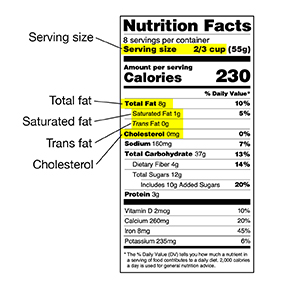Understanding Fat and Cholesterol
Too much cholesterol in your blood can lead to problems, such as blocked arteries. This can lead to heart attack and stroke. One of the best ways to manage heart and blood vessel disease is to lower your blood cholesterol. Eating meals that are low in saturated fat and trans fat helps reduce the level of cholesterol in your blood. Below are eating tips to help you do this.
Eat less fat
A healthy goal is to have less than 25% to 35% of your daily calories come from fat. Instead of fats, eat more fruits, whole grains, and vegetables. This also helps control your weight. It can even reduce your risk for some cancers. There are different kinds of fats in foods. Fats can be saturated, unsaturated, or trans fats. The best fats to choose are unsaturated fats. But fats are high in calories, so eat even unsaturated fats in small amounts.
Limit saturated fats
Saturated fats come from animals. They also come from certain plants, such as coconut and palm. Eating too much saturated fat can raise your blood cholesterol levels. This can make your artery problems worse. Your goal is to eat less saturated fat. Below are some examples of foods that contain a lot of saturated fat:
-
Fatty cuts of meat (lamb, ham, beef)
-
Many pastries, cakes, cookies, and candies
-
Cream, ice cream, sour cream, cheese, and butter, and foods made with them
-
Sauces made with butter or cream
-
Salad dressings with saturated fats
-
Foods that contain palm or coconut oil
Choose unsaturated fats
Unsaturated fats are usually liquid at room temperature. They are better choices for your heart than saturated fat. There are 2 types of unsaturated fats. Aim to replace saturated fats with these:
-
Polyunsaturated fats. These are found in corn oil, safflower oil, sunflower oil, and other vegetable oils.
-
Monounsaturated fats. These are found in olive oil, canola oil, and peanut oil. Some margarines and spreads are now made with these oils, too. Avocados are also high in monounsaturated fat. Of all fats, monounsaturated fats are the least harmful to your heart.
Don't eat trans fats
Like saturated fats, trans fats have been linked to heart disease. Even a small amount can harm your health. Trans fats are found in liquid oils that have been changed to be solid at room temperature. Margarine, which is often made from vegetable oil, is one example. Vegetable shortening is another. Trans fats are often found in highly processed and packaged goods. Check ingredients for the words partially hydrogenated. This means the foods contain trans fat.
What about triglycerides?
Triglycerides are a type of fat in your blood. Like cholesterol, high levels of triglycerides can lead to blocked arteries. High triglyceride levels can be reduced 20% to 50% by:
-
Limiting added sugars
-
Eating healthier fats
-
Choosing whole grains over refined grains
-
Getting more physical activity
-
Losing weight if you are overweight
You may also be advised to stay away from or limit alcohol.
Reading food labels
Most foods now have Nutrition Facts labels that give you the details about what you’re eating. Reading food labels helps you make healthy choices. Look for the words highlighted below.
-
Serving Size. This is the amount of food in 1 serving. If you eat larger portions, be sure to count more of everything: fat, calories, and cholesterol.
-
Total Fat. Tells you how many grams (g) of fat are in 1 serving.
-
Calories from Fat. This tells you the total number of calories from fat in 1 serving. There are 9 calories per gram of fat. Look for foods with the fewest calories from fat.
-
Saturated Fat. Tells you how many grams (g) of saturated fat are in 1 serving.
-
Trans Fat. Tells how many grams (g) of trans fat are in 1 serving.
-
Cholesterol. Tells you how many milligrams (mg) of cholesterol are in 1 serving.

Online Medical Reviewer:
Brittany Poulson MDA RDN CD CDE
Online Medical Reviewer:
Diane Horowitz MD
Online Medical Reviewer:
Heather M Trevino BSN RNC
Date Last Reviewed:
8/1/2022
© 2000-2025 The StayWell Company, LLC. All rights reserved. This information is not intended as a substitute for professional medical care. Always follow your healthcare professional's instructions.